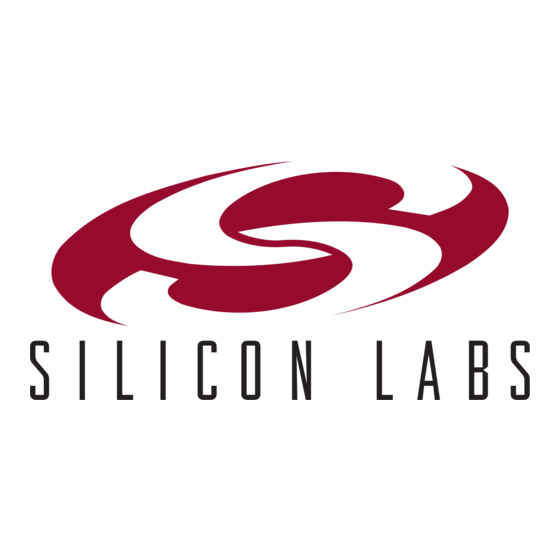
Table of Contents
Advertisement
Quick Links
C8051F326/7 D
1. Kit Contents
The C8051F326/7 Development Kit contains the following items:
• C8051F326 Target Board
• C8051Fxxx Development Kit Quick-Start Guide
• Silicon Laboratories IDE and Product Information CD-ROM. CD content includes:
• Silicon Laboratories Integrated Development Environment (IDE)
• Keil 8051 Development Tools (macro assembler, linker, evaluation 'C' compiler)
• Source code examples and register definition files
• Documentation
• C8051F326/7 Development Kit User's Guide (this document)
• USB Cable
• AC to DC Power Adapter
• USB Debug Adapter (USB to Debug Interface)
• USB Cable
2. Hardware Setup using a USB Debug Adapter
The target board is connected to a PC running the Silicon Laboratories IDE via the USB Debug Adapter as shown
in Figure 1.
1. Connect the USB Debug Adapter to the DEBUG connector on the target board with the 10-pin ribbon cable.
2. Connect one end of the USB cable to the USB connector on the USB Debug Adapter.
3. Connect the other end of the USB cable to a USB Port on the PC.
4. Connect the ac/dc power adapter to power jack P1 on the target board.
Notes:
• Use the Reset button in the IDE to reset the target when connected using a USB Debug Adapter.
• Remove power from the target board and the USB Debug Adapter before connecting or disconnecting the
ribbon cable from the target board. Connecting or disconnecting the cable when the devices have power can
damage the device and/or the USB Debug Adapter.
Rev. 0.2 9/06
E V E L O P M E N T
PC
USB
Cable
Figure 1. Hardware Setup using a USB Debug Adapter
Copyright © 2006 by Silicon Laboratories
C8051F326/ 7-DK
K
U
'
I T
S E R
AC/DC
Adapter
USB Debug Adapter
PWR
SILICON LABORATORIES
P1.6
Port 2
Port 1
G
S
U I D E
Target Board
MCU
Port 0
Port 3
Port 4
C8051F326/7-DK
Advertisement
Table of Contents

Summary of Contents for Silicon Laboratories C8051F326-DK
- Page 1 • USB Cable 2. Hardware Setup using a USB Debug Adapter The target board is connected to a PC running the Silicon Laboratories IDE via the USB Debug Adapter as shown in Figure 1. 1. Connect the USB Debug Adapter to the DEBUG connector on the target board with the 10-pin ribbon cable.
-
Page 2: Software Setup
ROM for additional information on using the Keil 8051 tools with the Silicon Laboratories IDE. To build an absolute object file using the Silicon Laboratories IDE project manager, you must first create a project. A project consists of a set of files, IDE configuration, debug views, and a target build configuration (list of files and tool configurations used as input to the assembler, compiler, and linker when building an output object file). - Page 3 C8051F326/7-DK 4.4.1. Creating a New Project → 1. Select Project New Project to open a new project and reset all configuration settings to default. → 2. Select File New File to open an editor window. Create your source file(s) and save the file(s) with a rec- ognized extension, such as .c, .h, or .asm, to enable color syntax highlighting.
-
Page 4: Example Source Code
C8051F326/7-DK 5. Example Source Code Example source code and register definition files are provided in the “SiLabs\MCU\Examples\C8051F326_7\” direc- tory during IDE installation. These files may be used as a template for code development. Example applications include a blinking LED example which configures the green LED on the target board to blink at a fixed rate. 5.1. -
Page 5: Target Board
C8051F326/7-DK 6. Target Board The C8051F326/7 Development Kit includes a target board with a C8051F326 device pre-installed for evaluation and preliminary software development. Numerous input/output (I/O) connections are provided to facilitate prototyp- ing using the target board. Refer to Figure 2 for the locations of the various I/O connectors. Power connector (accepts input from 7 to 15 VDC unregulated power adapter) 22-pin Expansion I/O connector Power Target Board from power adapter at P1... - Page 6 C8051F326/7-DK 6.1. System Clock Sources The C8051F326 device installed on the target board features a calibrated programmable internal oscillator which is enabled as the system clock source on reset. After reset, the internal oscillator operates at a frequency of 1.5 MHz (±1.5%) by default but may be configured by software to operate at other frequencies.
- Page 7 C8051F326/7-DK 6.4. Expansion I/O Connector (J1) The 22-pin Expansion I/O connector J1 provides access to all signal pins of the C8051F326 device. Pins for +3 V, and digital ground are also available. A through-hole prototyping area is also provided. Each connection point is labeled indicating the signal available at the connection point.
- Page 8 C8051F326/7-DK 6.6. Target Board DEBUG Interface (J4) The DEBUG connector (J4) provides access to the DEBUG (C2) pins of the C8051F326. It is used to connect the Serial Adapter or the USB Debug Adapter to the target board for in-circuit debugging and Flash programming. Table 4 shows the DEBUG pin definitions.
- Page 9 C8051F326/7-DK 7. Schematics Rev. 0.2...
- Page 10 C8051F326/7-DK Rev. 0.2...
-
Page 11: Document Change List
C8051F326/7-DK OCUMENT HANGE Revision 0.1 to Revision 0.2 Removed EC2 Serial Adapter from Kit Contents. Removed Section 2. Hardware Setup using an EC2 Serial Adapter. See RS232 Serial Adapter (EC2) User's Guide. Removed Section 8. EC2 Serial Adapter. See RS232 Serial Adapter (EC2) User's Guide. Removed Section 9. -
Page 12: Contact Information
Silicon Laboratories products are not designed, intended, or authorized for use in applications intended to support or sustain life, or for any other application in which the failure of the Silicon Laboratories product could create a situation where per- sonal injury or death may occur.

Need help?
Do you have a question about the C8051F326-DK and is the answer not in the manual?
Questions and answers